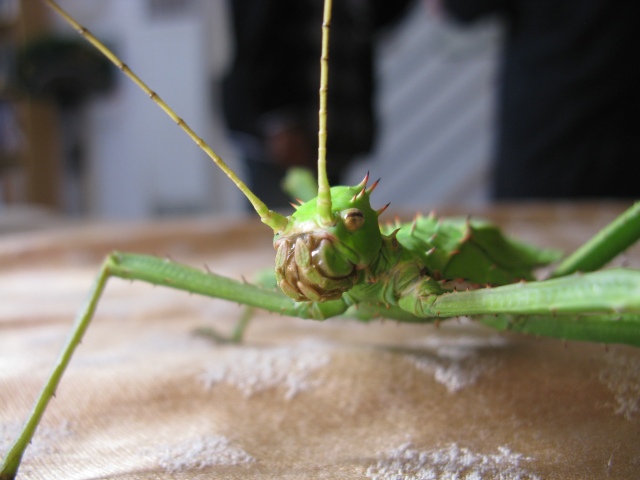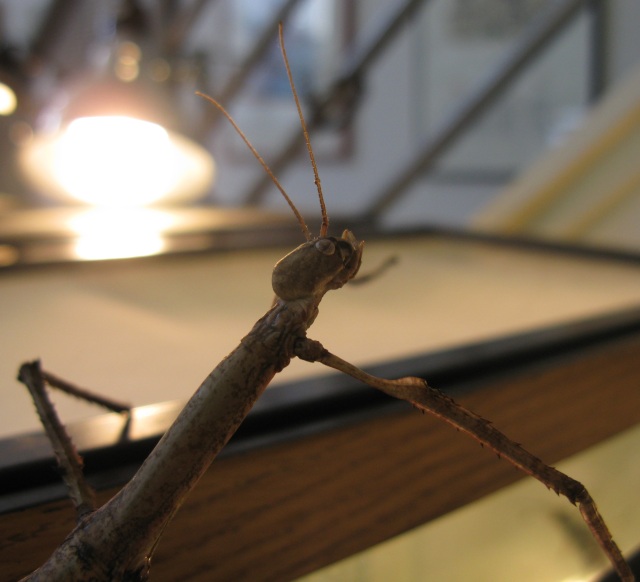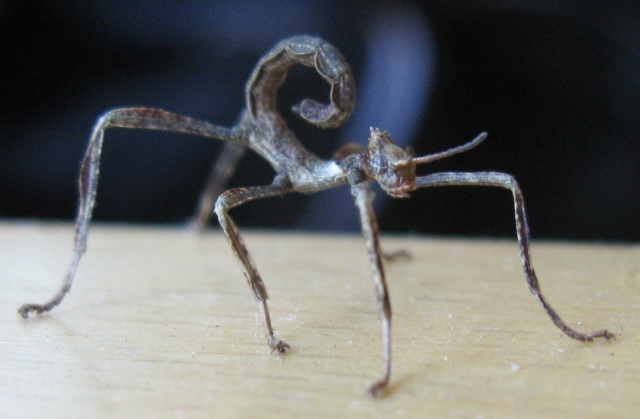This link has some of the most amazing photos of animal camouflage I have ever seen. Also, just in case you haven’t seen this amazing video yet:
Lest you think these animal have us beat in this category, check this out. We will catch up someday…

This giant thorny phasmid enthralled us with her most amusing antics. Image taken at the Insect Discovery Lab in San Francisco.
Walking sticks are most known for their amazing camouflage. But their camouflage often involves a lot more than simply their good looks. While having the shape and coloration of a leaf, like the one pictured above, or a stick, like the one shown below, certainly helps, it’s really just the beginning.

Stick insects can look like leaves or sticks. In some species, the females look like leaves and the males like sticks. Image taken at the Insect Discovery Lab.
Even their eggs are camouflaged, looking like plant seeds. But in addition to this, they also have behavioral adaptations that help them blend in or in some cases, mimic other animals.
For example, obviously, if you are trying to mimic a stick, then remaining still most of the time is pretty important. But, these animals take it a step further and will even flex their legs in such a way that keeps them in exact motion with the plant, which may be gently swaying in a breeze. Brown nymphs, or young walking sticks that haven’t reached the adult stage yet will hang from a twig and if they are disturbed, they will drop like a dead leaf. They’ve even been shown to hold their legs at exactly the same angle from the tree that the twigs around them are. All of these are behaviors that help keep them invisible to potential predators. That’s probably why these guys are in the Order Phasmida, which is from the Greek phasm, meaning phantom or apparition. They vanish from sight. Here’s a young insect among leaves, so you can see how well their camouflage works.

A young stick insect clings to some leaves, which provide camouflage as well as food. Here's a challenge-Can you find a cuter baby bug? Image taken at the San Francisco Zoo.
Still, some species can also mimic other animals. For example, Australian walking sticks are thought to curl their tails when discovered and threatened, perhaps to appear like a much more threatening scorpion.

This young Australian walking stick is curling its tail, perhaps to mimic a dead, curled leaf, or perhaps to mimic a scorpion. Image taken at the Insect Discovery Lab.
I have actually come across conflicting ideas about this strategy. On one side, some say they are not mimicking scorpions, but dead, curled up leaves. Since scorpions are on the ground and they generally live in trees it wouldn’t make sense to mimic them. But would the predator know that? Perhaps both ideas are in play. On a side note, these guys as adults also have wings that are brightly colored on the inside, which they can flash and startle predators with as well.
Another species of walking stick that mimics another invertebrate is the Spiny leaf insect, aka macleay’s spectre stick. In this case, when the insect lays its eggs, the eggs have little knobs on them which attract ants. The ants will carry them to underground nests, where they eat the knob, but leave the rest of the egg alone. Being in this underground nest grants them protection from predators. 1-3 years later, the eggs will hatch and the nymphs will emerge looking and behaving exactly like the red-headed black ants, until they molt.
The spectre stick is not the only walking stick with an interesting reproductive strategy. For example, there are a couple of other species where the females eject their eggs from their abdomens and scatter them about. Cyphocrania gigas can expel her eggs almost 20 feet away! By scattering their eggs, they reduce predation and competition between siblings.
Also, many walking sticks can reproduce asexually! That is, the females don’t have to mate with a male at all to produce offspring. It’s the true virgin birth. In some cases, it takes longer to reproduce asexually, but it’s still possible. For some walking sticks that do this, males are often hardly ever found.
Another interesting reproductive behavior-generally a male walking stick finds his mate by scent and then climbs onto her back to mate. The male will remain there for hours at a time, staying on the female so that no other male will have a chance to mate with her, thus insuring her offspring will be his. The much larger female seems to hardly notice, as she goes about her daily business as if nothing unusual is happening.
However they do it, if the eggs survive, they hatch and a new walking stick begins its life. The walking stick will go through several different molts (6-7 seems to be the general range) until they become adults. The Australian walking stick, might eat its exoskeleton after each molt and tend to get darker with age. The stage of life of an insect (actually arthropods, the larger group including insects) between molts is called an instar. Below are pictures of a couple of young walking sticks in different instars, so you can see some more juveniles.
These are the same species, just different sexes and instars.
Now here’s a different juvenile walking stick. Notice something missing?
Young walking sticks will give up a leg to a predator if it has to in order to get away. But this is not the tragedy it seems to be, because after several molts, they can actually regenerate their limbs! So none the worry for this little guy; he’ll be good as new before he’s an adult.
Now this picture is of the giant thorny phasmid, aka the Maylayan Stick Insect. This is the same bug as in the first picture, but I included this picture to show the scale (and her useless wings). You can see that she is roughly the size of my hand, full grown. Now, that’s a big insect. But not the biggest. I wouldn’t be doing stick insects justice if I left out the fact that the largest insect discovered in the world so far is a phasmid. They can range in size from a small half of an inch to a record 1.86 feet or 22.32 inches. Not including it’s legs, it’s 14 inches long. And yet, I suppose if there has to be an almost 2-foot long insect, I’m glad it’s a walking stick. They are fascinating, pleasant-to-be-around insects. This girl shown above goes to schools and meets kids on a regular basis, to teach them about insects and the rain forest her relatives live in.
Well, just in case you haven’t had enough of stick insects yet, here is a cool picture of one nomming a leaf. Stick insects eat plants. Is that cannibalism?
Now, you might think that a plant-eating animal that sits still and hides all day poses no threat to potential predators. But a few walking sticks do have some other defenses. For example, some have giant spines on their legs, like this one shown below. They will use these spines as a defense, but also in competition between males.
Ouch! But that’s not the winner. No, I think the award goes to the musk mare, aka the two-striped walking stick. This insect can shoot out a chemical spray with pretty high accuracy. If they get their potential predator in the eye, they can cause temporary blindness and in extreme cases, they can cause corneal damage. And they can spray more than a foot away.
Anyway, this post is just a glance at a few of the ~3,000 known species of stick insect, and just a small fraction of the cool things they can do. If you’d like to learn more, a good place to start is with the Australian Museum’s site, which discusses several species I didn’t mention here. Also, many zoos and aquariums have stick insects, so checking out your local facilities might yield some cool experiences and observations as well.
And last, but not least, special thanks to phasmid wrangler Will Mckennet for raising these animals since they were eggs, and sharing them with us.